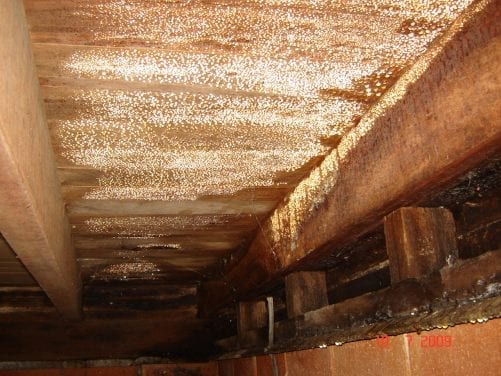Learn about causes of dry rot and damage it can cause to sub-floor timber.
Dry rot damage to sub-floor timber. QBIS. Condensation is occuring to the underside of this timber floor from evaporation of water that has ponded on the soil below. This is causing the timber to decay.
Dry-rot causing destruction of floor structure.
The floor joists, bearers and flooring have been damaged beyond repair from dry-rot. The timber cannot be repaired, affected timber must be replaced.
Assessment for cause and source of problem must first be determined before an effective solution can be carried out. And more importantly, before replacing any timber to avoid the fault recurring.
Causes of dry-rot to sub-floor timber.
- Inadequate drainage.
- Ponding of water below a floor.
- Insufficient clearances between soil and timber.
- Lack of cross flow ventilation
Combination of these problems cause fungal decay of the timber over a period of time
Worth knowing: Dry rot is caused by evaporation of water and condensation without direct water contact.
Some potential telltale signs of dry-rot occuring.
- Musty smell to interior of a building.
- Blackening around flooring nails caused by rust.
- Breathing problems with inhabitants.
- Mould forming to walls and ceilings (sometimes caused by insufficient ventilation, humidity also house being closed up during day).
These problems can be unhealthy for inhabitants, if in doubt, seek advice from a professional.
How to stop dry-rot from recurring.
- Fit effective drains.
- Fit crossflow ventilation (if this cannot be achieved) fit a mechanical ventilation system.
- Lower outside paving and soil levels to levels that are below the sub-floor.
- Create required clearances between all timber and soil.
In most cases, an effective, economical rectification cannot be achieved without major reconstruction, at a great expense.
What you need to know about dry rot.
Dry rot is often mistaken with wet rot.
- Wet rot is caused from leaking as opposed to condensation of water on timber from water ponding.
- Dry rot can cause health problems with inhabitants of buildings.
Without removing affected timber and creating appropriate ventilation and ground clearances, there is no effective longterm solution.


